│By Philip Virta, Senior Acquisitions Editor, Gale Primary Sources│
Enfer is a French word that translates to Inferno or Hell, and according to some religions, Hell is the place of punishment for the wicked, the damned, the morally corrupt, once death has befallen them. It is thus only fitting that books considered “contrary to public morality” should end up in Enfer. Aside from its literal meaning of Hell, Enfer is the shelf mark of the restricted books collection at the Bibliothèque nationale de France (BnF). A shelf mark is simply a notation or classification on a book showing its place in a library. In the 1830s, a time when the BnF was opening to a wider audience, the institution began to assign the Enfer classification to books considered to be obscene works. Whether the books were locked away because they truly were reprehensible, or merely to protect them from those who would proscribe or destroy them, it is to our benefit today as they have been preserved for our study.
On the subject of study, Enfer provides us with many opportunities to explore art and social history in a wide variety of imaginative works. While some of the books simply offer flights of fancy, erotic fantasies to titillate and arouse, many of the works in Enfer offer social commentary and criticism. After exploring the fantastic imagery in texts from the seventeenth to nineteenth century, I was intrigued to continue my search and explore how imagery developed in the late nineteenth and twentieth century, when authors and artists were often at the forefront of the social and cultural movements of their time.
In the twentieth century, erotic art became more adventurous, not only in what it depicted, but in the art forms used. A variety of twentieth-century art and design movements, from abstract expressionism to art deco to pop art to surrealism, are illustrated in the books of Enfer. Additionally, erotic literature changed with the times. Some of the works still offered social commentary and criticism, but there were just as many texts dealing with love, sexual desires, fetishes, and outright pornography.
In the interest of exploring art and social history in twentieth-century erotica, let us descend into the fabulous, scandalous, and enticing digital collection of L’Enfer de la Bibliothèque nationale de France.
Erotic Courtesan Fantasy
Paris-Éros is a work of erotic courtesan fantasies written by Auguste Dumont under the pen name Martial d’Estoc. It is set in Paris and offers a fictional, yet historically accurate, view of the society and culture of the city in the early twentieth century. The stories involve what one would expect in an erotic novel, such as prostitution, lesbian sex (likely driven by male fantasy), fashionable courtesans, passionate orgies and erotomania. While the book may or may not stand on its own literary merits, the included illustrations are beautifully rendered.
Gaston Noury (17 December 1866 in Elbeuf, Normandy – 21 September 1936 Le Havre, Normandy) provided illustrations for Paris-Éros. Noury was a French painter, poster artist, illustrator, cartoonist, and theatrical costume designer, working in Le Havre and Paris, where he settled around 1889. He was a prolific artist, and his work was featured in everything from posters to books, postcards to songbooks. Noury was a costume designer for the Moulin Rouge and Ambassadeurs in the Montmartre district of Paris, where his artistic talents likely served him well.
His drawings for Paris-Éros featured a combination of pencil and watercolour washes, depicting women and men in elegant attire and seductive poses. Aside from the titillating qualities of some of the illustrations, it is interesting to see the fashions of the period depicted. One such illustration shows two fashionably dressed ladies likely wearing corsets that gave their figures the wasp-waisted look that was in vogue.
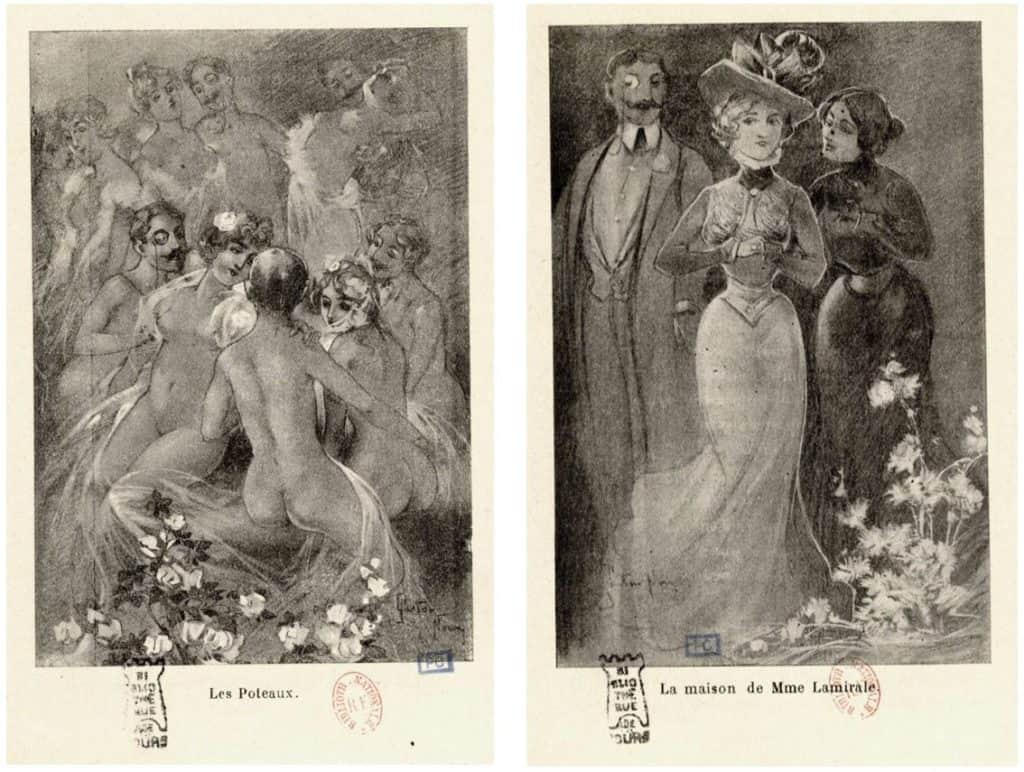
Left: https://link.gale.com/apps/doc/GDAAIR446444339/AHSI?u=omni&sid=AHSI&xid=9376408d&pg=137
Right: https://link.gale.com/apps/doc/GDAAIR446444339/AHSI?u=omni&sid=AHSI&xid=9376408d&pg=45
The Novel de Flagellation
Le Cinglant Argument is one of the books in a sub-collection of Enfer known as Flagellation. Between the 1880s and the 1930s, an editorial subgenre flourished in France: the novel de flagellation, a specialized branch of erotic literature. In this context, “passionate flogging” is a sexual act consisting of experiencing an erotic pleasure to be whipped. The Flagellation books in Enfer consist of literary works on spanking, caning, and whipping.
The six short stories featured in Le Cinglant Argument feature characters whose sexual frustrations and desires find release in all sorts of flagellation. The sixteen illustrations featured in this book, illustrated by an anonymous artist, leave no doubt this is a flagellation novel; they offer a wonderful visual aspect to the stories. Aside from the erotic nature of the illustrations, it is interesting to see the fashions, furnishings, and stylings of the turn of the twentieth century brought to life.
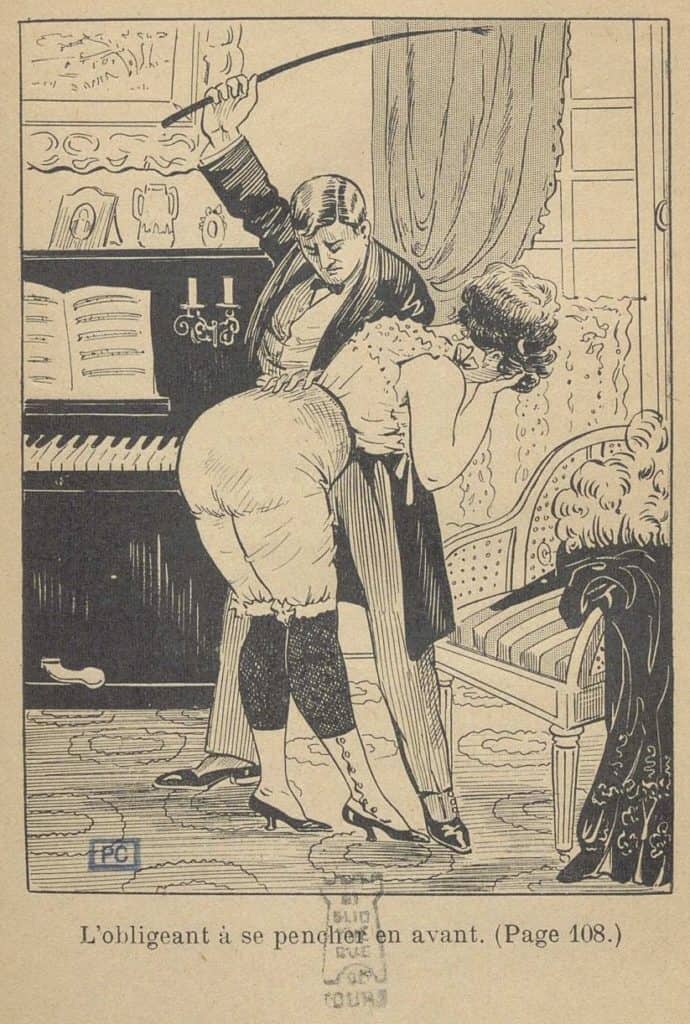
Récits Piquants Chaudes Aventures, essentially “Spicy Tales, Hot Adventures” is another flagellation novel, a topic that was popular in the late nineteenth and early twentieth century. The book features six stories, three long tales and three short stories, of passion, sexual frustration, and the art of flogging. This is a work written for the entertainment of the disciples of the lash, nothing more, nothing less. Récits Piquants Chaudes Aventures is interesting as a testimony to a sexual fetish that dominated erotic publishing for the better part of fifty years. Whether or not the book has any redeeming social value, or offers any kind of worthy social critique, is up to you to discover. It is mentioned here for its fascinating depictions of a bygone era. The illustrations in this book were done by Georges Töpfer, a prolific erotic artist whose work appeared in multiple books of the early twentieth century. Featuring fringe wraps, drop-waist dresses, and bob haircuts, the finely rendered drawings nicely portray the stylings and fashions of the 1920s.
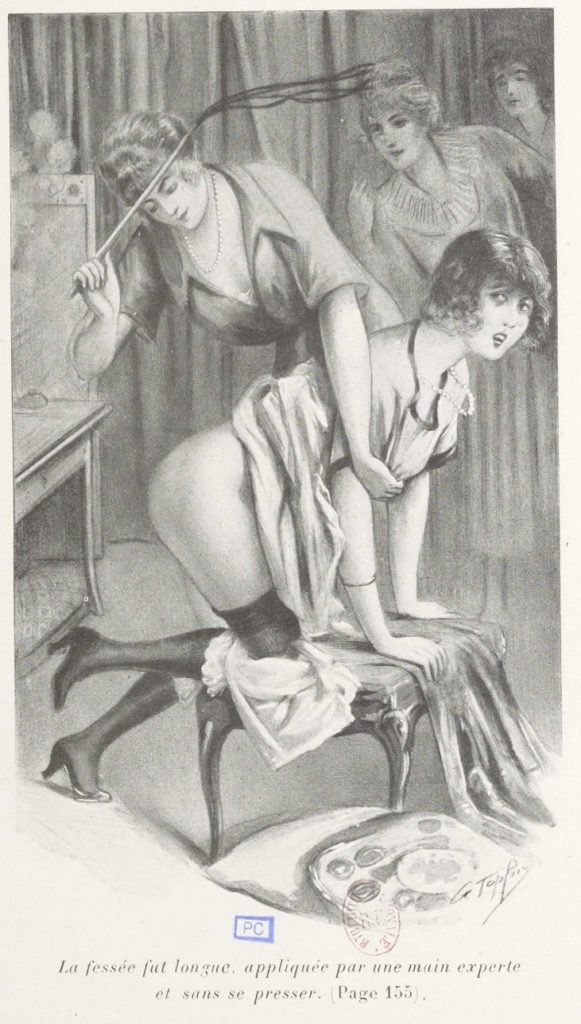
Surrealism
Surrealism was a cultural movement which developed in Europe in the aftermath of World War I and was largely influenced by Dadaism. According to André Breton, surrealism utilised art and literature to “resolve the previously contradictory conditions of dream and reality into an absolute reality, a super-reality”, or “surreality”. Surrealist artists and writers frequently employed free association, dream analysis, and the unconscious mind to create their works. Surrealism was a philosophical movement, but also a revolutionary movement most commonly associated with communism and anarchism. From the 1920’s onward, Paris was a centre of the surrealist movement, so it is no surprise to see a number of works in Enfer written and illustrated in surrealist style.
Georges Hugnet (11 July 1906 – 26 June 1974) was a French graphic artist. He was also active as a poet, writer, art historian, bookbinding designer, critic and film director. According to one source, Hugnet’s early rebelliousness eventually developed into a combative, stubborn nature causing quarrels with publishers, other artists, poets, friends, and family throughout his life. In the 1940s, Hugnet was part of the French Resistance in German-occupied France. In 1943, Hugnet collaborated with Spanish surrealist Óscar Domínguez to create Le feu au cul, a term generally used with someone who is on the lookout for sexual liaison opportunities. The book of art and poetry was published secretly during the wartime occupation. Hugnet’s erotic poetry was well paired with Dominguez’s overtly sexual artwork, which, “demonstrated an unceasing preoccupation with the subconscious, with automatism and with unfettered spontaneity.”
Óscar Domínguez was a Spanish artist best known for his loosely rendered Surrealist paintings. Influenced by avant-garde European painters such as René Magritte, Giorgio de Chirico, and Yves Tanguy, he employed bizarre subject matter to great effect. Domínguez, like Max Ernst, used a technique called decalcomania, a technique used by some surrealist artists which involves pressing paint between sheets of paper.
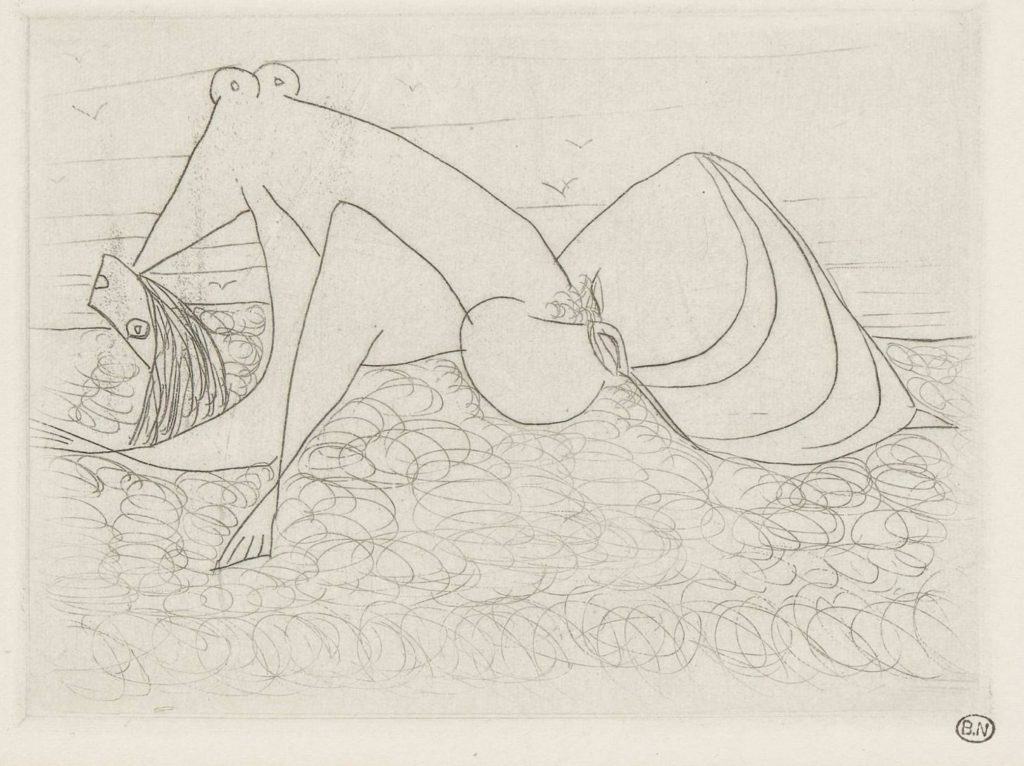
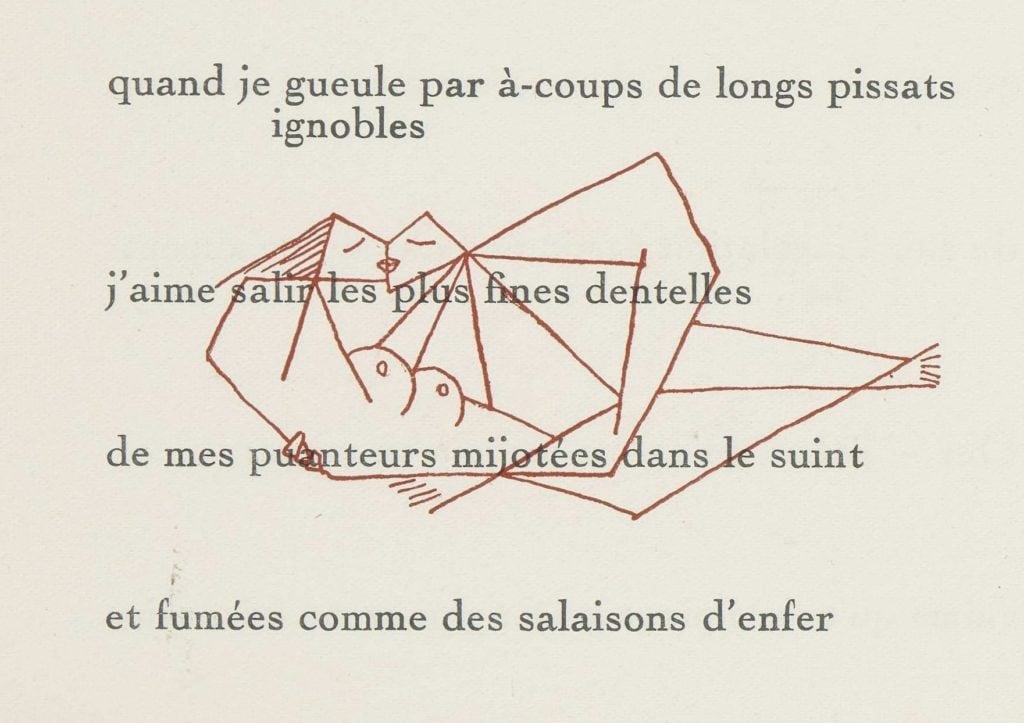
Illustration for plays
Henri René Albert Guy de Maupassant (5 August 1850 – 6 July 1893) was a nineteenth-century French author and a representative of the Naturalist school. Maupassant wrote and performed in the quasi-pornographic drama A la feuille de rose, maison turque in 1875. The comedic play satirises a bourgeois couple’s experiences in a brothel that they take to be the residence of the Turkish ambassador and his harem. The play was performed at least twice in 1875 and 1877, and possibly more, although this is not documented. All the male or female roles were played by a small troop made up of Maupassant himself and his friends, the French artist Robert Pinchon, Octave Mirbeau, and Léon Fontaine. Pinchon played “The Toque,” The Captain, a Hunchback, An Englishman, and a Cesspit emptier, and Maupassant went in drag to play a “loose woman” under the alias of Joseph Prunier. Gustave Flaubert, the patron of Maupassant, immensely enjoyed the performance, laughing himself to tears and applauding with all his might. Throughout the performance he kept repeating to his neighbour, Emile Zola: “Nom de Dieu it’s refreshing!”
The text of the play was published in 1945 in a limited printing of 225 numbered copies. This edition from Enfer is copy number 3 and features some delightful coloured lithographs graphically recreating scenes from the play. The two scenes depicted feature a salon with oriental hangings and a brothel parlour, both of which are hidden behind “card curtains” that could be folded out to reveal the actors. The art is naturalistic, yet comic, reflecting the misadventures of the protagonists.

Left: https://link.gale.com/apps/doc/GDTLVQ153556106/AHSI?u=omni&sid=AHSI&xid=32b93350&pg=22
Right: https://link.gale.com/apps/doc/GDTLVQ153556106/AHSI?u=omni&sid=AHSI&xid=32b93350&pg=74
Homosexual Erotica
Jean Genet, (born December 19, 1910, Paris – died April 15, 1986, Paris) spent his early life as a petty thief and a vagabond, yet later became a writer, playwright and human rights activist. Genet was also openly homosexual, and many of his works explicitly portrayed themes of homosexuality and criminality, reflective of his own life journey. In 1947, Genet published La Galère (The Galley), a poetic work about a virile murderer who is transformed into a tragic “queen” in a fantasy involving a galley ship transporting prisoners to a penal colony in Guyana.
Argentine-Italian surrealist painter Leonor Fini was invited to illustrate La Galère and created six etchings depicting explicit sexual activities between men. Finding homosexual erotica can be challenging given past social attitudes toward homosexuality. In 1956, Genet was given a fine and a suspended prison sentence for publishing the illustrated editions of La Galère and Querelle de Brest, both of which were considered “in contempt of morality”. Finding a work that artistically depicts gay intimacy, especially illustrated by a female artist, is something of a rarity.
Leonor Fini was an Argentine-Italian painter who spent much of her artistic career in France. Associated with the Surrealist movement, Fini’s self-portraits and mythological paintings focused on eroticism and dreams. “Paintings, like dreams, have a life of their own and I have always painted very much the way I dream,” she once said.
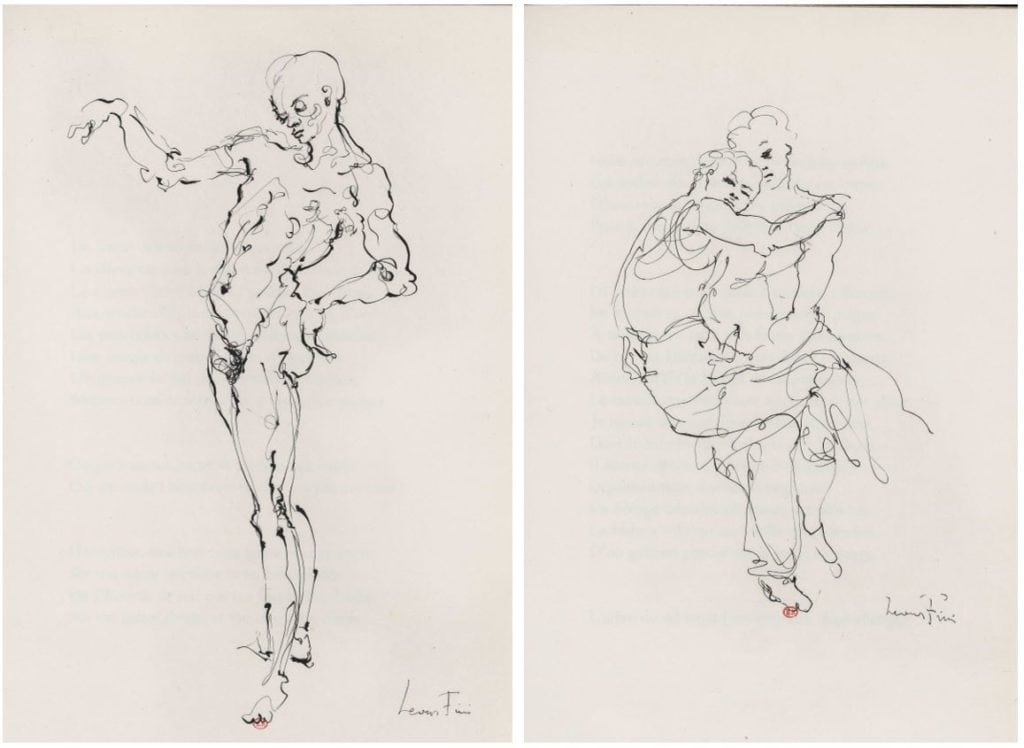
Left: https://link.gale.com/apps/doc/GEILBK698847083/AHSI?u=omni&sid=AHSI&xid=eafc0675&pg=25
Right: https://link.gale.com/apps/doc/GEILBK698847083/AHSI?u=omni&sid=AHSI&xid=eafc0675&pg=31
Delve into the fascinating lives and histories of the authors and artists in Enfer
Some of the erotic literature and art in Enfer, published between the sixteenth to twentieth centuries, was created for sexual gratification, titillation and amorous fantasies. The descriptions and depictions of sexual escapades and episodes can be arousing, humorous and sensual, or display the darker aspects of human desire. Enfer is more than just erotica; many of the works in the collection offer intriguing social commentaries and criticisms, and the opportunity to delve into the fascinating lives and histories of the authors and artists themselves, as well as the social and cultural movements they represented. Don’t be afraid to venture beneath the book covers and read between the lines; you never know what you will find in Enfer!
If you enjoyed reading about the images in nineteenth and early twentieth texts in L’Enfer de la Bibliothèque nationale de France, you may enjoy Phil’s discussion of images in earlier works from the seventeenth to nineteenth century. You may also be interested in reading about another module in Gale’s Archives of Sexuality and Gender series, Sex and Sexuality, Sixteenth to Twentieth Century, in Sex! … and Sexuality, and Gender which discusses the Private Case from the British Library, materials from the Alfred C. Kinsey Institute for Sex Research and the New York Academy of Medicine.
Blog post cover image citation: This montage design was created from images found throughout this blog post. Please see image captions for full citation.

